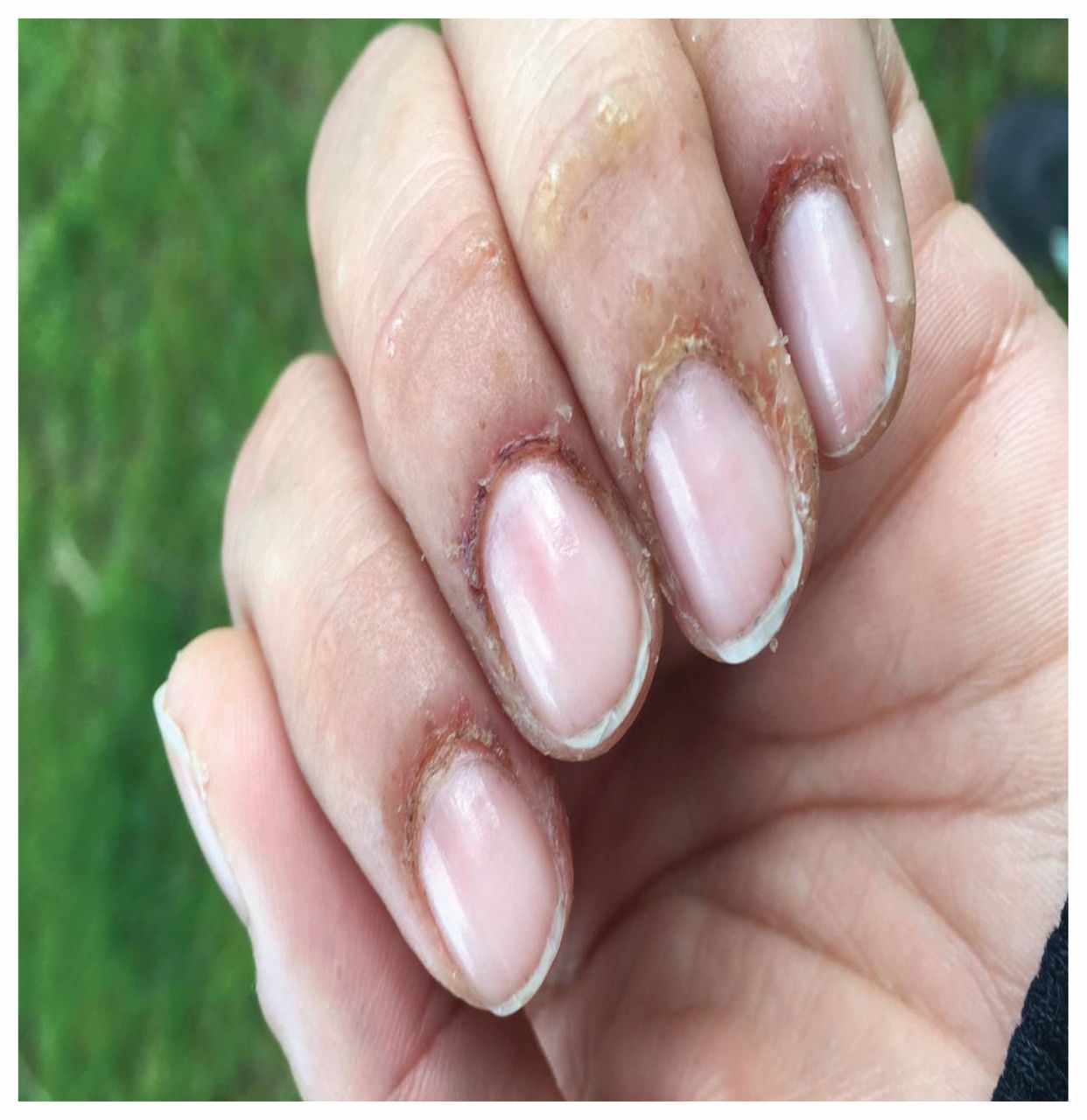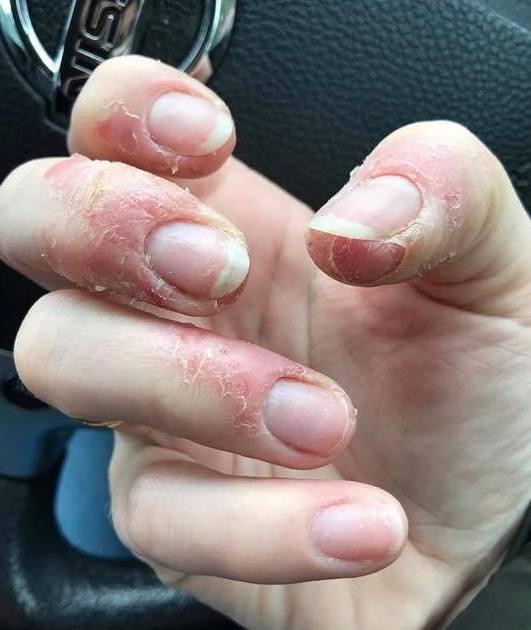Contact Dermatitis From Nails: Causes, Symptoms & Tips
Are your meticulously manicured nails causing more trouble than they're worth? If you're experiencing redness, itching, or swelling around your nails, you might be dealing with contact dermatitis, a common skin reaction linked to nail products.
Contact dermatitis is a skin condition that arises when your skin comes into direct contact with a substance it finds irritating or to which it's allergic. This contact can trigger an itchy rash, often accompanied by redness, blisters, or swelling. While not contagious, this condition can be incredibly uncomfortable, impacting your daily life and potentially even your ability to work. The culprits are many and varied, ranging from household items like detergents and soaps to beauty products like cosmetics and fragrances. In the context of nail care, the focus often falls on the chemicals found in acrylic and gel nail products.
To understand the scope of this condition better, consider the following details.
- May 29 Zodiac Gemini Traits Horoscope Compatibility
- Christine Chubbuck Suicide The Untold Story Lost Footage Explained
| Aspect | Details |
|---|---|
| Type of Condition | Contact Dermatitis |
| Primary Cause | Direct contact with an irritant or allergen, often found in nail products like acrylics and gel polishes. |
| Common Symptoms | Redness, itching, swelling, blisters, and sometimes skin lesions near the nails, on fingertips, and potentially spreading to other areas like the eyes. |
| Common Irritants/Allergens |
|
| Affected Population | Anyone at any age, from babies to adults. Nail technicians (stylists) may also be at higher risk due to occupational exposure. |
| Impact on Daily Life | Can cause discomfort, impact fitness for work, and lead to sick leave in severe cases, as reported in cases of significant fingertip dermatitis. |
| Treatment Options | (Not specifically listed in the content, but typical treatments include avoidance of irritants, topical corticosteroids, and emollients to soothe the skin. Consulting a dermatologist is crucial for diagnosis and appropriate treatment.) |
| Key Study/Research |
|
| Noteworthy Fact | Isobornyl acrylate, often used as an adhesive in nail products, was named the contact allergen of the year in 2019 by the American Contact Dermatitis Society. Routine allergy tests may not identify it. |
| Additional Information | See more details at American Academy of Dermatology |
The origins of this unwelcome reaction are diverse. Contact dermatitis can be triggered by a single exposure or emerge over time with repeated contact. In the realm of nail enhancements, specific chemicals present in acrylic nail products are frequently implicated. Methylmethacrylate, for instance, was first documented as a culprit back in 1941. While occupational allergies to acrylates have been observed across various professions, including dentistry and the printing industry, reports of contact dermatitis linked to artificial acrylic nails have become increasingly prevalent with their rising popularity. In some cases, reactions can be severe, with individuals experiencing skin lesions, lip swelling, or widespread skin issues.
Its crucial to understand the potential impact of gel nail polish, as well. For some, like those who have used it over a year, can find themselves developing contact dermatitis under the nails, with the skin peeling and fingertips becoming itchy. The underlying cause stems from the substances found in the gel itself. The first documented cases of allergic contact dermatitis from acrylates in manicure procedures date back decades, specifically related to the application of porcelain nails.
The situation is further complicated by the fact that there are two primary types of contact dermatitis: irritant and allergic. Irritant contact dermatitis is more common and stems from direct irritation, while allergic contact dermatitis is a delayed reaction to a specific chemical. Both types manifest as a rash that can potentially spread to other areas of the body. For example, scratching an itchy eye after applying nail polish could lead to swelling and further irritation.
Many of the ingredients in nail cosmetic products can sensitize the immune system, leading to contact dermatitis. Common culprits include tosylamide, (meth)acrylates, and formaldehyde. A clear temporal relationship is often observed, meaning that an outbreak on the hands, face, or other areas often follows procedures like nail enhancements. Acrylic nails and gel nails are both potential sources of this allergic reaction, often manifesting on the fingertips.
Its important to recognize the potential risks. Professional application does not guarantee immunity. While occasional skin contact during a manicure is inevitable, frequent or prolonged contact, such as when the brush constantly touches the skin, is a major cause for concern. The increased awareness of the risks associated with nail products should also extend to professional nail technicians, who are exposed to these chemicals daily. It's a two-way street, where both consumers and professionals can develop allergic reactions.
In 2019, the American Contact Dermatitis Society identified isobornyl acrylate, an acrylic monomer frequently used as an adhesive, as the contact allergen of the year. This highlights the need for increased clinician awareness, as routine allergy testing may not always detect its presence.
The implications of contact dermatitis extend beyond mere discomfort. Cases have been reported where individuals experiencing severe fingertip dermatitis and onychodystrophy (nail dystrophy) from preformed nails had to take extended sick leave. The severity of the reaction can significantly impact an individual's ability to work and perform daily tasks.
If you're experiencing symptoms like itchiness, redness, peeling, or any unusual changes near your nails after getting your nails done, consult a dermatologist or healthcare professional. Early diagnosis and appropriate management can help to alleviate symptoms and improve your overall well-being.
- Lizzy Mcalpine Michael Hanano Split What You Need To Know
- Goodmans Appliances More Explore Kitchen Beauty Essentials

Contact dermatitis caused by methacrylates in nail products CMAJ

Dermatitis NailKnowledge

Allergic Contact Dermatitis to Acrylate Chemicals in Artificial Nails